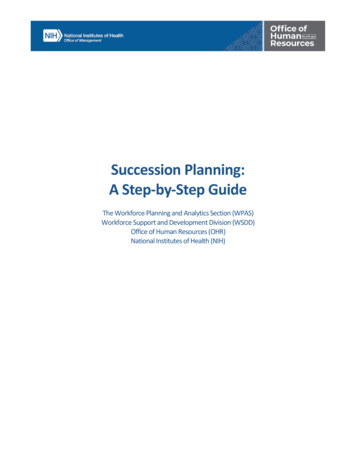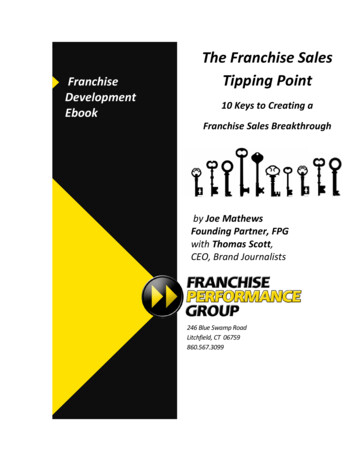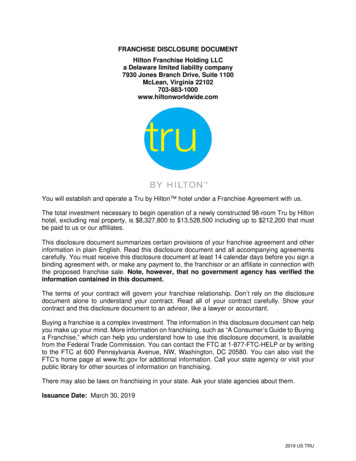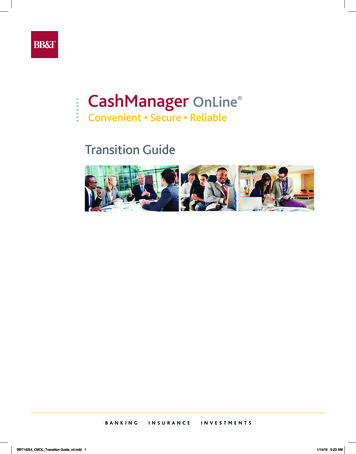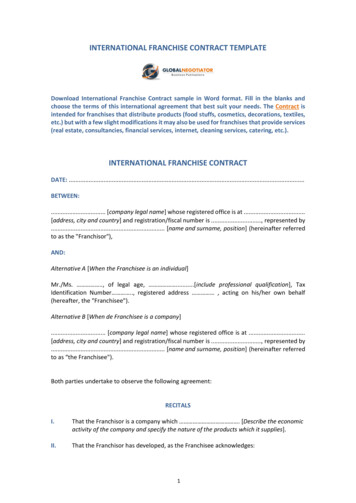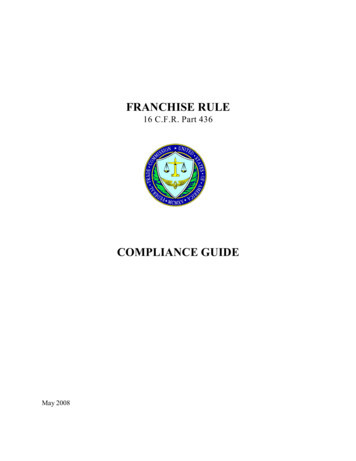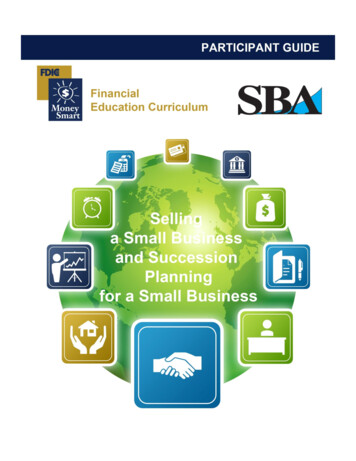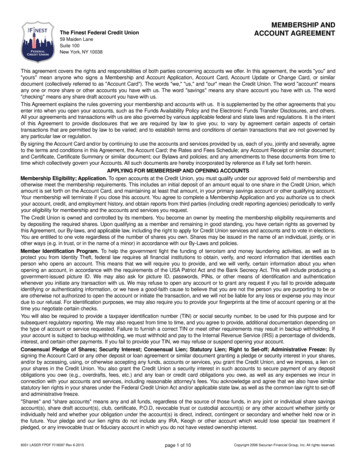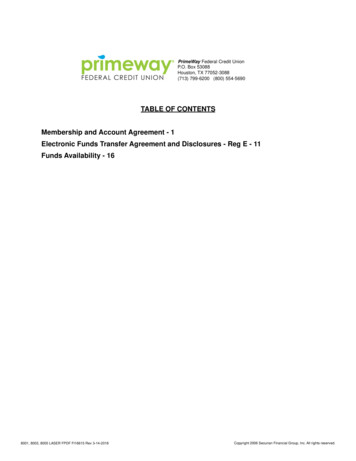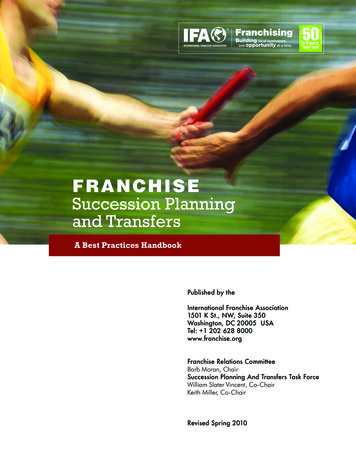
Transcription
FranchiseSuccession Planningand TransfersA Best Practices HandbookPublished by theInternational Franchise Association1501 K St., NW, Suite 350Washington, DC 20005 USATel: 1 202 628 8000www.franchise.orgFranchise Relations CommitteeBarb Moran, ChairSuccession Planning And Transfers Task ForceWilliam Slater Vincent, Co-ChairKeith Miller, Co-ChairRevised Spring 2010
Table of ContentsFOREWARD.IABOUT IFA.IIIFA FRANCHISE RELATIONS COMMITTEE. IIIII.SUCCESSION PLANNINGA. INTRODUCTION. 1B. WHY A SUCCESSION PLAN IS NEEDED. 2C. THE SUCCESSION PLAN. 3i.Develop Team of Advisors. 3ii.Identify Qualities Successor Must Possess. 3iii. Identify the Successor. 3iv. Train the Successor. 4v.Final Thoughts – Legal & Tax Issues. 5D. CONCLUSION. 5IIII. THE SALE AND TRANSFER OF THE FRANCHISEA. INTRODUCTION. 6B. EXIT STRATEGY. 6i. Selling to an Outsider. 7ii. Marketability of the Franchise Business. 7iii. Valuation of the Business. 8iv. Valuation Methods. 8v. Selling to an Employee. 8C. THE TRANSFER PROCESS. 9i. Locating Prospective Buyers. 10ii. Approval/Disapproval Process. 11iii. The Importance of Establishing a Transfer Policy. 11iv. A Perfect World Transfer Scenario. 12v. What Normally Happens in the Transfer Scenario. 13vi. Locating Buyers. 13vii. Unqualified Candidates in Transfers. 14viii. Transfer Fees. 14D. TRANSFER DOCUMENTATION. 15i. Documentation. 15ii. Consent to Transfer. 16iii. Applicable State Laws. 16iv. Disclosure. 17v. Transfer Procedures. 17E. TRAINING AND OPERATIONAL SUPPORT FOR TRANSFEREES. 18i. Differences Compared to a New Franchisee. 18ii. Compliance Review at Transfer. 18iii. Initial Training Programs. 18iv. On-Site Visitations. 19v. How to Get New Transferees Up-To-Speed Operationally. 19vi. Mentor Programs. 20F.CONCLUSION . 21IFA Franchise Succession Planning & Transfers Handbook
Franchise Succession Planning and TransfersForewordSelling and transferring ownership of a franchised business isIsomething that many franchisees do not think about until theyare at the point where they are retiring or ready to sell theirbusinesses. Many people mistakenly assume this is a simpleprocess, but there are myriad decisions to make before afranchised business can be sold and ownership transferred.Perhaps the best way to prepare is to create a succession plan– an advance strategy that maps out how a franchisee plans toremove himself from the business in the future and transfer it to anew franchisee owner, who could be a family member or a thirdparty buyer.This handbook provides a blueprint for establishing a successionplan along with a list of decisions to be made in the planningprocess.Selling and transferring ownership of the business not onlyaffects the franchisee, but also the franchisor. One sectiondiscusses how franchisors can work with their franchisees to finda suitable buyer for their franchise. Having a plan in advancewill make this sometimes emotionally difficult process easier toexecute.IFA Franchise Succession Planning & Transfers Handbook
IIAbout the International Franchise AssociationThe International Franchise Association, the world’s oldest and largest organizationrepresenting franchising, is the preeminent voice and acknowledged leader for theindustry worldwide. Currently celebrating a half-century of service with a growingmembership of more than 1,100 franchise systems, 10,000-plus franchisees and morethan 500 firms that supply goods and services to the industry, IFA protects, enhances andpromotes franchising by advancing the values of integrity, respect, trust, commitment toexcellence, honesty and diversity.IFA MissionProtect, enhance and promote franchisingIFA VisionThe preeminent voice and acknowledged leader for franchising worldwideIFA Strategic Priorities Government relationsPublic relationsEducation and professional developmentIFA ValuesIntegrity Infusing high ethical standards into all effortsRespect Showing thoughtful consideration for all members, staff and others with whom we workTrust Faithfully fulfilling our responsibilities to membersExcellence Delivering high quality content and programs that propel franchising forwardDiversity Embracing the diversity of individuals, ideas and perspectivesFor more information, visit the IFA Web site at www.franchise.org.IFA Franchise Succession Planning & Transfers Handbook
IIIIFA Franchise Relations CommitteeThe IFA’s Franchise Relations Committee is dedicated to developing information and programs thatpromote positive relations and encourage dialogue and cooperation between franchisees andfranchisors. For additional content produced by the Franchise Relations Committee, please b Moran, Moran Industries, Inc.ChairmanBarry Miller, Sylvan Learning Center of Girard, OhioVice-ChairKeith Miller, Subway FranchiseeVice-ChairMichael Bamrick, CFE, Jack In The Box, Inc.Bruce Bloom, CFE, Bloom & Associates, LLCJoe Bourdow, CFE, ValpakSteve Bridge, California Fresh of Lompoc, CAMary Beth Brody, CFE, Faegre & Benson LLPJanice Dwyer, CFE, Luce, Smith and Scott, Inc.Paul Eckert, Family Financial Centers, LLCDonald Higginson, MBE, a UPS CompanyHarvey Homsey, Express Employment ProfessionalsKen Houck, CFE, Golden Corral Buffet & GrillChuck Jones, CFE, HouseMaster Home Inspection ServicesJohn Kujawa, McDonald’s CorporationPaul Mangiamele, CFE, Salsarita’sLisa McCarthy, Out Of The Box TechnologyCatherine Monson, FASTSIGNS InternationalRay Moore, CFE, BrightStar Franchising, LLCJack Pearce, CFE, Annex Brands, Inc.Andrew Perrin, Larkin Hoffman Daly & LindgrenSteven Rafsky, Padgett Business ServicesRobert Sells, CFE, Sells Development, Inc.Linda Shunk, CFE, Oreck Franchise Services, LLCTim Shuy, Choice Hotels InternationalKeith Singletary, Chick-fil-A Capital CentreJim Squire, CFE, HoneyBaked Ham Company and CaféEric Stites, CFE, Franchise Business ReviewLarry Tate, Golden Corral Buffet & GrillWilliam Vincent, Life University; Foot Solutions, Inc.David Wells, CFE, Snap-on-Tools Company, LLCIFA Franchise Succession Planning & Transfers Handbook
I. SUCCESSION PLANNINGA.INTRODUCTIONAmerica’s business community is built upon family-ownedbusinesses which includes franchises. More than 90 % ofall businesses in the United States are family-owned andemploy 62 % of the private sector workforce. Two-thirds of thenation’s Gross Domestic Product is produced by family-ownedbusinesses. Further, over the last 20 years, more than 80 %of the net new jobs created in the United Stated were createdby family-owned businesses. A large number of family-ownedbusinesses are franchise businesses of which over 900,000exist today.1In order to ensure thecontinuity of ownership bythe family of a franchise,a succession planmust be developed andimplemented.Unfortunately, statistics are not very good as pertains to thecontinuation of family-owned and franchise businesses. Almost70 % of all businesses fail to survive to the second generation.Of those that do survive, only 12 % make it to the thirdgeneration. A considerable number of franchised businessowners would like to maintain ownership of their franchisesafter retirement. However, for several reasons this does nothappen in 70 % of businesses. One of the primary causes of afamily business not staying in the family is the failure to createand execute a management succession plan. Other majorreasons include inadequate estate planning, and the subsequentlack of funds to pay estate taxes.Most business owners want their businesses to survive them andthe vast majority, exceeding 80 %, want to pass their business,or franchises, on to their children or other family members.However, the number one reason this does not occur is dueto the lack of a viable succession plan. Therefore, in order toensure the continuity of ownership by the family of a franchise,a succession plan must be developed and implemented.IFA Franchise Succession Planning & Transfers Handbook
B. WHY A SUCCESSION PLAN IS NEEDEDApproximately 70 % of family-owned franchises will not survive theretirement of the original owner without a succession plan in place.There are many reasons why the owner may not be able to continueto operate the franchise and needs to have a replacement waiting totake over. For example, one never knows when he may die or becomephysically incapacitated due to an illness. Also, there are legal andfinancial problems that can arise in which the owner needs to beimmediately replaced by a successor. There have even been caseswhere the owner has, without notice, walked away because he hadhad enough and wanted to go into immediate retirement. However, atsome point in time a successor will take over for the original owner ofthe franchise. And the point is, one never knows when that successorwill need to take over. As we have always been taught, an ounceof prevention is worth a pound of cure and therefore it is of extremeimportance to have a succession plan in place if the owner of thefranchise wants to maintain ownership as opposed to transferring it toanother.Approximately 70%of family-ownedfranchises will notsurvive the retirementof the original ownerwithout a successionplan in place.2There are several competing interests when the owner does need toretire. If members of his family are also employees they might feellike they should be the successor. Also, if the owner has severalchildren each of them may feel that they should be put in charge of thefranchise. Additionally, there are non-family employees that, becauseof their length of service or importance to the franchise, want to becomethe successor to the owner, or at least obtain a stake in the franchise.Even when there are no family members of the owner actively involvedin the franchise, there can still be pressure applied because these familymembers want to ensure that they will end up owning the business ifsomething should happen to the owner. For these reasons and others,an effective and complete succession plan needs to be implemented byeach franchise owner to ensure the continued success of the franchise inthe event the original franchise owner is no longer able to or willing tolead and operate the franchise.IFA Franchise Succession Planning & Transfers Handbook
C.THE SUCCESSION PLAN(i) DEVELOP TEAM OF ADVISORSThe franchise owner needs to control the succession plan from beginning to end. After all, itis his company and therefore needs to control the management continuity strategy. The ownercan select to do this in one of two ways. First, the owner might decide just to work with selectedmembers of his or her family and allow immediate family members to actively participate inhelping the owner decide upon a successor. Second, the owner might decide it is advisableto bring in professional advisors such as an attorney or business experts in his industry thatknow what qualities are imperative for a successor to have to be a successful replacement ofthe owner. Regardless of what approach is taken, it is advisable to contact the franchisor anddetermine what help the franchisor offers with regard to transfers. Often times the owner willfind it beneficial to combine both strategies and select a successor based upon input from bothhis immediate family members and professional advisors.(ii) IDENTIFY QUALITIES SUCCESSOR MUST POSSESS3Once the franchisee has his team of advisors in place he must identify those qualities that hissuccessor must possess in order to successfully run and operate the franchise. Many franchisorsrequire certain qualifications of a successor to the existing franchisee. Depending upon thetype of franchise, there could be some very specific and highly technical qualities that must bepossessed by a potential successor. Such qualities would be ascertained by the franchisee, hisadvisors, and the franchisor as part of his succession plan. However, there are many qualitiesthat the successor must possess that are common to all franchises. For example, the successormust qualify as a franchisee and have a complete knowledge of the business he or she is torun and operate, or at least the ability to acquire this knowledge within an acceptable timeframe. Further, the successor must possess the traits of enthusiasm, persistence, determination,willingness to learn, and basic intellectual capacity. Other qualities would include the ability toplan and organize, able to solve problems, an eye for detail, along with good health, plenty ofenergy, and a gung-ho attitude.(iii) IDENTIFY THE SUCCESSOROnce the first and second steps of the succession plan have been completed, it is now timeto identify potential successors. Oftentimes, the franchisee will assume that his children willwant to take over the business and be the successor. However, the owner of the franchise mustidentify the right successor for his business whether or not it is one of his children or anotherfamily member.The franchisee should make it clear to each of his children and other family members whether ornot he or she is required to join the business on a full time basis. Also, it might be appropriateto give the potential family member successor the opportunity to work outside the business first togain valuable skills in other business settings. This is done by Chick-fil-A with the grandchildrenof the founder. The franchisee must realize that the successor may or may not come from withinhis or her family. Further, it is possible that, if there are two strong contenders for successors,the franchisee may work with both of them to be his successor and both may be responsible forthe effective operation of the business upon his retirement.IFA Franchise Succession Planning & Transfers Handbook
The two main reasons franchisees do not put a succession plan into place or give it muchthought is because one, they feel like they have plenty of time to do so and two, that theymight offend family members if they pick one over another. However, it is interesting tonote that the average life span of a family-owned business is 24 years and that is also theaverage time the original owner is at the helm of the franchise. However, never knowingwhat will happen tomorrow, it is always important early on in the life of a franchisebusiness to have a succession plan in place so that successors can be groomed becausethey may be needed sooner than later.(iv) TRAIN THE SUCCESSORNow that the successor has been picked, and assuming any legal matters are taken careof, the franchisee must train the successor by transferring his knowledge to him graduallyover time. Depending upon the franchise, the owner will need a transition period of oneto three years to adequately train his successor. The successor must follow a successionplan that includes education about the business. This may include attending the requiredfranchisor training course(s) and working with the current owner to learn everything thereis about the business. The successor must get to know the franchise’s most importantcustomers along with its key suppliers, vendors, and other people in businesses that havecontributed to the success of the franchise. The franchisee must convey the key factorsthat he feels has led to his success and those key factors that he feels will lead to successin the future. As much as possible, the franchisee must document all of his knowledgeand processes so that the successor will know how things are done and why. Much ofthis knowledge is already contained in the operations manual provided by the franchisor.However, the owner will still contribute much knowledge in the successful operation of thefranchise that is not contained in the operations manual and other materials provided bythe franchisor.4Gradually the franchisee must show his trust in his successor by delegating more andmore responsibilities to him. The owner must realize that the successor may makemistakes from time to time and needs to be there to assist in correcting the mistakesand turn them into learning experiences. Further, the owner needs to provide his or hersuccessor with the appropriate documents that are required to efficiently operate thefranchise. These documents include such items as financial statements, insurance policies,key contracts, corporate and/or other business documents that dictate how the business isto be run, along with sharing all franchisor materials with the successor.Initially the successor will shadow the franchisee and just watch the franchisee. Graduallythe owner will delegate more and more responsibilities to his successor so that he caneffectively train him. Also, this transition period allows for not only the other employeesof the franchise but also for the franchisee’s customers, suppliers, and vendors to developconfidence in the successor as well. The end result is that all parties come to identify thefranchise with the successor as opposed to the original owner.IFA Franchise Succession Planning & Transfers Handbook
(v) FINAL THOUGHTS – LEGAL AND TAX ISSUESFinally, the succession plan, as part of the franchisee’s estate planning, must be structured insuch a way as to minimize the impact of estate, gift, and inheritance taxes on family membersand the business. Franchise owners who fail to consider the potential impact of estate andinheritance taxes could easily force, upon their passing, their remaining family members to sellthe business in order to pay the estate’s tax bill. At this point it is critical to have a tax attorneyand a CPA who specializes in taxes to determine which vehicles are best in order to minimizethese taxes. Several items that can be utilized in order to do this are items such as family limitedpartnerships, an estate freeze, various types of trusts, lifetime gifting, and buy-sell agreements.The franchisee must cover these issues with competent legal and tax counsel and any furtherdiscussion of these types of legal options is beyond the scope of this handbook. However,before the owner of franchise can determine which options to utilize from a legal and taxperspective, he must first check with his franchisor in order to determine if written permission isneeded from the franchisor in order for the owner to participate in one of these legal strategies.After all, the franchisor will want to know what is going on and will want to review whatever isdone before it is done concerning these items.D.5CONCLUSIONA franchise owner, upon purchase of a franchise, should already be implementing a successionplan. One never knows when a successor will have to take over long before expected.Therefore, it is always better to be proactive than reactive. However, not all franchise ownersare looking to develop a succession plan because for whatever reason they have alreadydecided they will sell the franchise to a third party, which could include a family member.Therefore, for those situations, the second part of this handbook covers the sale of a business,which under franchising is referred to as transfers.One never knows when asuccessor will have to takeover long before expected.It is always better to beproactive than reactive.IFA Franchise Succession Planning & Transfers Handbook
II. THE SALE AND TRANSFER OF THE FRANCHISEA.INTRODUCTIONEntrepreneurs rarely take the time to consider how theyare going to handle ‘the end’ at the start-up or during thelife of a business. Little thought is given to the implicationsof a transfer or succession of a franchised business with athorough review of the applicable franchise documents.6For manyentrepreneurs,it is difficult toconsider thedissolution of thefranchise at the onset.For many entrepreneurs, it is difficult to consider thedissolution of the franchise at the onset. Many choose tooptimistically focus on the benefits and potential. Even if aclear understanding exists initially about the process andprocedures for a transfer or succession of the franchise, it israrely revisited or reconsidered during the life of the business.Only on the occasion of a significant event like an illnessor retirement does the issue get the attention it deserves.And the result is all too often less satisfying than it mighthave been if a process to exit the system had been clearlydocumented and agreed upon at the beginning of thefranchise relationship.B. EXIT STRATEGYAn important part of any succession plan is the exit strategyfor the franchise owner. Disability, retirement, death – theseare all issues that must be planned for and addressed. Thetiming of a transition depends on a number of factors, suchas the franchisee’s age, health, retirement goals, and thereadiness of a buyer/successor. The franchisee must considerwhether to maintain some involvement with the business ormake a clean break.The following are potential non-family successors in the saleof your business:a. an outsiderb. an existing employee and possibly retaining partialownershipc. a select group or to all of your employeesIFA Franchise Succession Planning & Transfers Handbook
Of course, all three of these are subject to the franchise agreement terms and provisionsconcerning renewal, termination, repurchase, modification and assignment of the franchise.There are contract restrictions on the franchisee’s right to freely transfer the franchise. Thesecontract limitations are sometimes also subject to separate state legislation.These standard franchise agreement provisions enable franchise systems to enforce high qualitystandards and ensure uniformity. Failure to comply with these restrictions generally becomescause for default and termination of the agreement and exposes the franchisee to the risk ofending up with no franchise at all. So it is of utmost importance to make all plans within thescope of the appropriate provisions of the franchise agreement.(i)SELLING TO AN OUTSIDERThe outsider challenge is identifying someone interested in and familiar with your business, thenqualifying them both operationally and financially, and matching their personality and skill set tothe franchise concept.7One example is a vendor or supplier prepared to move into business ownership.A key supplier of ice machines with a long working relationship with a regional distributorenjoyed the end-user customer contact so much that he purchased the business when thedistributor/seller left to begin his next career. However, the first place to look is to the franchisor.Many franchise systems assist franchisees with locating a successor and handling the resultanttransfer.Another source of interested parties may be a client that is subject to downsizing and/orconsolidation of a large corporation who is prepared to secure their future by purchasing abusiness. A third party referral, such as a business broker or a broker’s referral network mayspeed the process of qualifying and matching possible prospects.(ii)MARKETABILITY OF THE FRANCHISE BUSINESSBuy low and sell high is always a great idea, whether it is a stock or a business. Sell the storewhen sales are climbing, placing the buyer in a positive state of mind and psychologicallyprepared to make the purchase. The following are important to the buyer. A fully trained staff is an attractive assetAll key management positions are filledThe lower the debt load of a business the higher the liquidity and cash flowSeverability of real estate from the businessComplete and detailed corporate books and recordsA positive EBITDA (Earnings Before Interest, Taxes, Depreciation, & Amortization) trend lineA franchise that is not overly dependent on the owner for its operational success andprofitability The age and condition of the equipment and facilitiesIFA Franchise Succession Planning & Transfers Handbook
(iii)VALUATION OF THE BUSINESSThere are valuation issues in the event of death for franchisees with a substantial net worth.The estate tax – even as modified by the Economic Growth and Tax Relief Reconciliation Act of2001 – is a principal consideration in developing the succession plan. The Internal RevenueCode requires the estate tax to be imposed upon the fair market value of the estate of thedeceased at the time of death. Franchises can present unique problems in the area of valuation.A major reason for preparing a succession plan is to avoid the prospect of a forced sale that
each franchise owner to ensure the continued success of the franchise in the event the original franchise owner is no longer able to or willing to lead and operate the franchise. 2 Approximately 70% of family-owned franchises will not survive the retirement of the original
